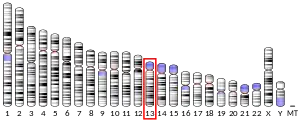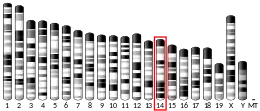G-protein coupled receptor 183 also known as Epstein-Barr virus-induced G-protein coupled receptor 2 (EBI2) is a protein (GPCR) expressed on the surface of some immune cells, namely B cells and T cells; in humans it is encoded by the GPR183 gene.[5] Expression of EBI2 is one critical mediator of immune cell localization within lymph nodes, responsible in part for the coordination of B cell, T cell, and dendritic cell movement and interaction following antigen exposure.[6][7][8][9] EBI2 is a receptor for oxysterols.[10][11] The most potent activator is 7α,25-dihydroxycholesterol (7α,25-OHC), with other oxysterols exhibiting varying affinities for the receptor.[8][7] Oxysterol gradients drive chemotaxis, attracting the EBI2-expressing cells to locations of high ligand concentration.[6][7][8][9] The GPR183 gene was identified due to its upregulation during Epstein-Barr virus infection of the Burkitt's lymphoma cell line BL41, hence its name: EBI2.[12]
Tissue distribution and function
B cells
EBI2 helps B cell homing to the outer follicular region within a lymph node. Approximately three hours following B cell exposure to plasma-soluble antigen, EBI2 is upregulated via the transcription factor BRRF1.[6] More surface receptors binding the oxysterol ligand results in cellular migration up the gradient, to the outer follicular region.[8] The reason for this early migration is still unknown; however, because soluble antigen enters lymph nodes via afferent lymphatic vasculature, near the outer region of the follicle, it is hypothesized that B cell movement is motivated by increased exposure to the antigen.[8][6] Six hours after antigen exposure, EBI2 is downregulated to low levels, permitting the B cells to migrate to the border between the B cell and T cell zones of the lymph node. Here, B cells interact with T helper cells previously activated by antigen-presenting dendritic cells. Though CCR7 is the dominant receptor in this stage of B cell migration, EBI2 is still critical, the low expression of which contributes to organized interaction along the T zone border that maximizes interactions with T cells.[8][6] Following B cell receptor and CD40 co-stimulation, EBI2 is again upregulated.[13] The B cells thus move back toward the outer follicular space, where they begin cell division.[8] At this point, a B cell either downregulates EBI2 expression in order to enter a germinal center or maintains EBI2 expression and remains in outer follicular regions. In germinal centers (GC), B cells downregulate the receptor via the transcriptional repressor B-cell lymphoma-6 (BCL6) and, following somatic hypermutation, differentiate into long-lived antibody-secreting plasma cells or memory B cells. EBI2 must turn off to move B cells to the germinal center from the periphery, and must turn on for B cells to exit the germinal center and re-enter the periphery.[13] Meanwhile, those remaining outside the follicle differentiate into plasmablasts, eventually becoming short-lived plasma cells.[6][8] Thus, EBI2 expression modulates B cell differentiation by directing cells toward or away from germinal centers.
T cells
EBI2 also regulates intra-lymphatic T cell migration. Mature T helper cells upregulate EBI2 to follow the oxysterol gradient, migrating to the outer edges of the T cell zone to receive signals from antigen-presenting dendritic cells arriving from the tissues.[6] This migration is critical as the resulting T cell-DC interaction induces T helper cell differentiation into T follicular helper cells.[14] In concert with upregulation of CXCR5, the downregulation of EBI2 helps T follicular helper cells move toward the follicle center to help B cells undergoing affinity maturation in germinal centers.[6]
Dendritic cells
EBI2 expression on CD4+ dendritic cells is a key initiator of immune response. Antigen-activated dendritic cells are driven to lymph node bridging channels via the oxysterol-EBI2 pathway.[9] In the spleen, bridging channels connect the marginal zone, where dendritic cells pick up plasma-soluble antigen, to the T cell zone, where they present antigen to T helper cells. This results in T cell proliferation and differentiation.[6] Localization to bridging channels is also associated with dendritic cell reception of lymphotoxin beta signaling, which augments their blood pathogen uptake, resulting in an increase in T cell responses.[7]
Ligand
Oxysterols bind to and activate EBI2.[10][11] The highest affinity oxysterol ligand is 7α,25-dihydroxycholesterol (7α,25-OHC), formed by enzymatic oxidation of cholesterol by the hydroxylases CH25H and CYP7B1.[7] 7α,25-OHC is concentrated in bridging channels and the outer perimeter of B cell follicles. Conversely it is not present in follicle centers, germ centers, nor in the T zone.[6][8] The enzymes responsible for ligand biosynthesis, CH25H and CYP7B1, are unsurprisingly abundant in lymphoid stromal cells. On the other hand, the enzyme that deactivates the ligand, HSD3B7, is highly concentrated in areas where the ligand concentration should be lowest—the T zone.[7] Though it is not a cytokine, the EBI2 ligand acts much like a chemokine in that its gradient drives cellular migration.
Virus infection
GPR183 plays a crucial role in driving inflammation in the lungs during severe viral respiratory infections such as influenza A virus (IAV) and SARS-CoV-2. Studies using preclinical murine models of infection revealed that the activation of GPR183 by oxidized cholesterols leads to the recruitment of monocytes/macrophages and the production of inflammatory cytokines in the lungs.[15]
References
- 1 2 3 GRCh38: Ensembl release 89: ENSG00000169508 - Ensembl, May 2017
- 1 2 3 GRCm38: Ensembl release 89: ENSMUSG00000051212 - Ensembl, May 2017
- ↑ "Human PubMed Reference:". National Center for Biotechnology Information, U.S. National Library of Medicine.
- ↑ "Mouse PubMed Reference:". National Center for Biotechnology Information, U.S. National Library of Medicine.
- ↑ "Entrez Gene: EBI2 Epstein-Barr virus induced gene 2 (lymphocyte-specific G protein-coupled receptor)".
- 1 2 3 4 5 6 7 8 9 10 Barington L, Wanke F, Niss Arfelt K, Holst PJ, Kurschus FC, Rosenkilde MM (August 2018). "EBI2 in splenic and local immune responses and in autoimmunity". Journal of Leukocyte Biology. 104 (2): 313–322. doi:10.1002/JLB.2VMR1217-510R. PMID 29741800. S2CID 13699151.
- 1 2 3 4 5 6 Kurschus FC, Wanke F (October 2018). "EBI2 - Sensor for dihydroxycholesterol gradients in neuroinflammation". Biochimie. "Current trends in oxysterols and related sterols". 153: 52–55. doi:10.1016/j.biochi.2018.04.014. PMID 29689289. S2CID 13855522.
- 1 2 3 4 5 6 7 8 9 Gatto D, Brink R (July 2013). "B cell localization: regulation by EBI2 and its oxysterol ligand". Trends in Immunology. 34 (7): 336–341. doi:10.1016/j.it.2013.01.007. PMID 23481574.
- 1 2 3 Daugvilaite V, Arfelt KN, Benned-Jensen T, Sailer AW, Rosenkilde MM (July 2014). "Oxysterol-EBI2 signaling in immune regulation and viral infection". European Journal of Immunology. 44 (7): 1904–1912. doi:10.1002/eji.201444493. PMC 4209795. PMID 24810762.
- 1 2 Liu C, Yang XV, Wu J, Kuei C, Mani NS, Zhang L, et al. (July 2011). "Oxysterols direct B-cell migration through EBI2". Nature. 475 (7357): 519–523. doi:10.1038/nature10226. PMID 21796211. S2CID 4414566.
- 1 2 Hannedouche S, Zhang J, Yi T, Shen W, Nguyen D, Pereira JP, et al. (July 2011). "Oxysterols direct immune cell migration via EBI2". Nature. 475 (7357): 524–527. doi:10.1038/nature10280. PMC 4297623. PMID 21796212.
- ↑ Birkenbach M, Josefsen K, Yalamanchili R, Lenoir G, Kieff E (April 1993). "Epstein-Barr virus-induced genes: first lymphocyte-specific G protein-coupled peptide receptors". Journal of Virology. 67 (4): 2209–2220. doi:10.1128/JVI.67.4.2209-2220.1993. PMC 240341. PMID 8383238.
- 1 2 Pereira JP, Kelly LM, Xu Y, Cyster JG (August 2009). "EBI2 mediates B cell segregation between the outer and centre follicle". Nature. 460 (7259): 1122–1126. Bibcode:2009Natur.460.1122P. doi:10.1038/nature08226. PMC 2809436. PMID 19597478.
- ↑ Willinger T (April 2019). "Oxysterols in intestinal immunity and inflammation". Journal of Internal Medicine. 285 (4): 367–380. doi:10.1111/joim.12855. PMC 7379495. PMID 30478861.
- ↑ Foo CX, Bartlett S, Chew KY, Ngo MD, Bielefeldt-Ohmann H, Arachchige BJ, et al. (March 2023). "GPR183 antagonism reduces macrophage infiltration in influenza and SARS-CoV-2 infection". The European Respiratory Journal. 61 (3). doi:10.1183/13993003.01306-2022. PMC 9686317. PMID 36396144.
Further reading
- Maruyama K, Sugano S (January 1994). "Oligo-capping: a simple method to replace the cap structure of eukaryotic mRNAs with oligoribonucleotides". Gene. 138 (1–2): 171–174. doi:10.1016/0378-1119(94)90802-8. PMID 8125298.
- Suzuki Y, Yoshitomo-Nakagawa K, Maruyama K, Suyama A, Sugano S (October 1997). "Construction and characterization of a full length-enriched and a 5'-end-enriched cDNA library". Gene. 200 (1–2): 149–156. doi:10.1016/S0378-1119(97)00411-3. PMID 9373149.
- Rosenkilde MM, Benned-Jensen T, Andersen H, Holst PJ, Kledal TN, Lüttichau HR, et al. (May 2006). "Molecular pharmacological phenotyping of EBI2. An orphan seven-transmembrane receptor with constitutive activity". The Journal of Biological Chemistry. 281 (19): 13199–13208. doi:10.1074/jbc.M602245200. PMID 16540462.
This article incorporates text from the United States National Library of Medicine, which is in the public domain.




